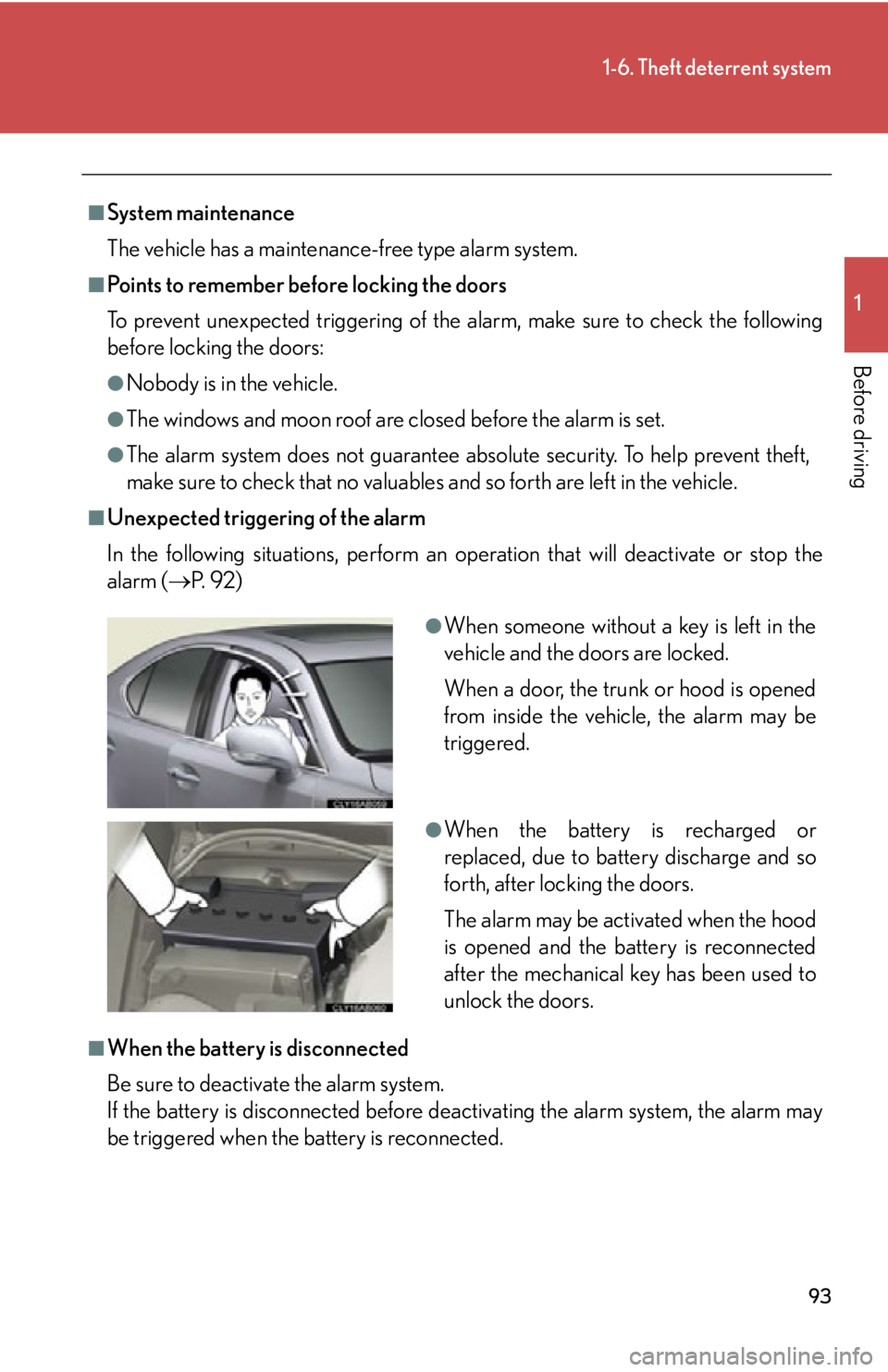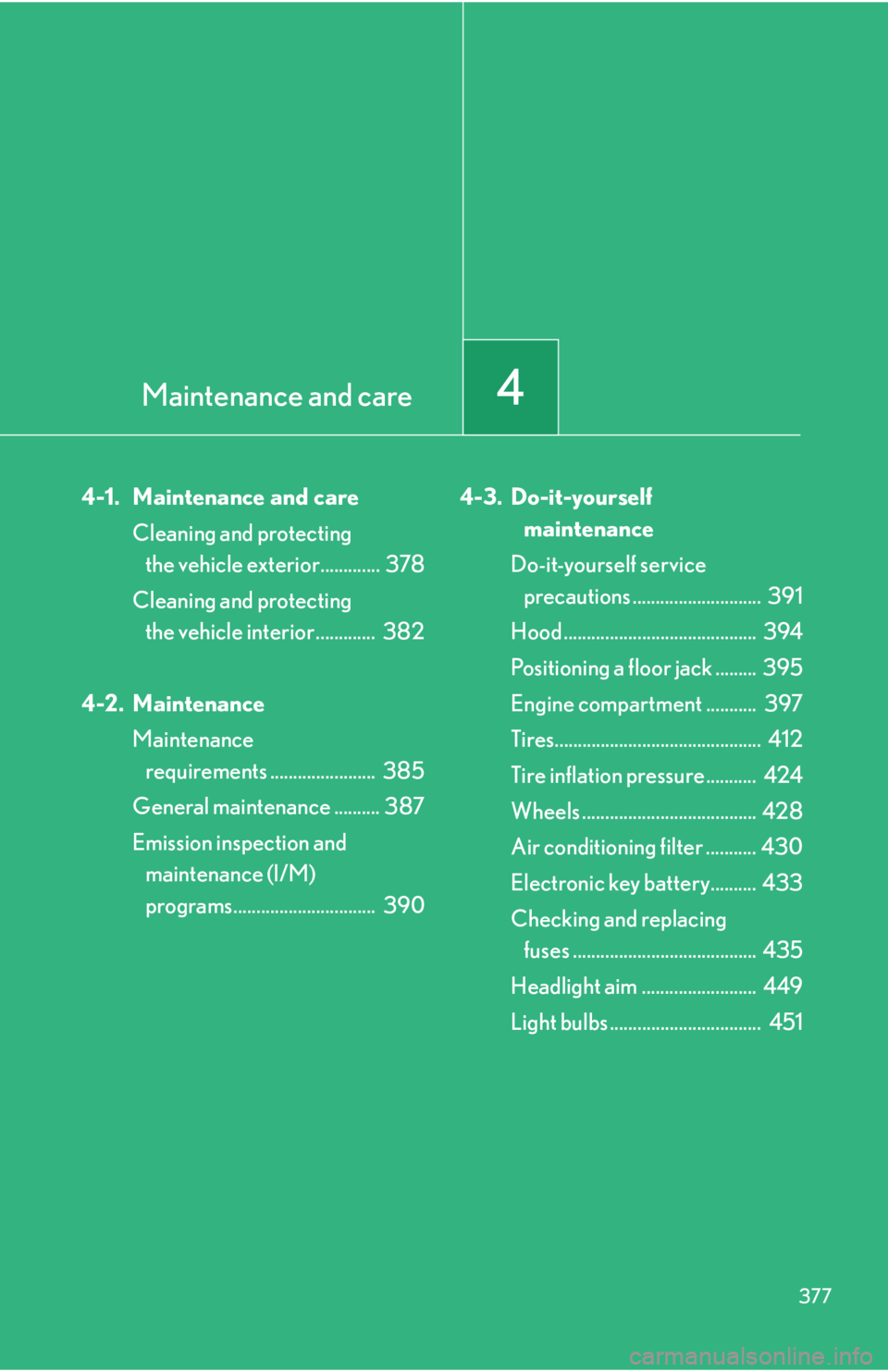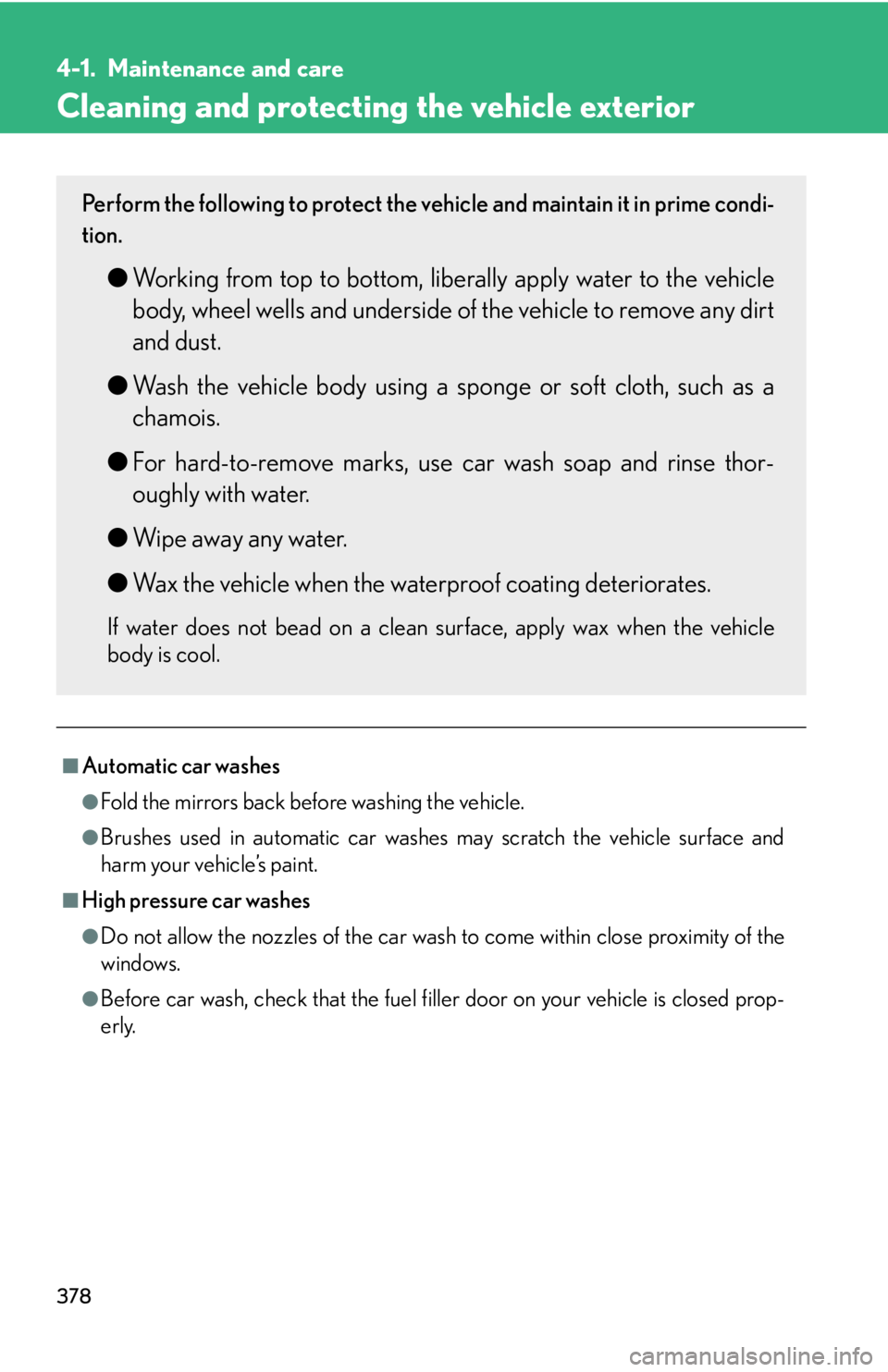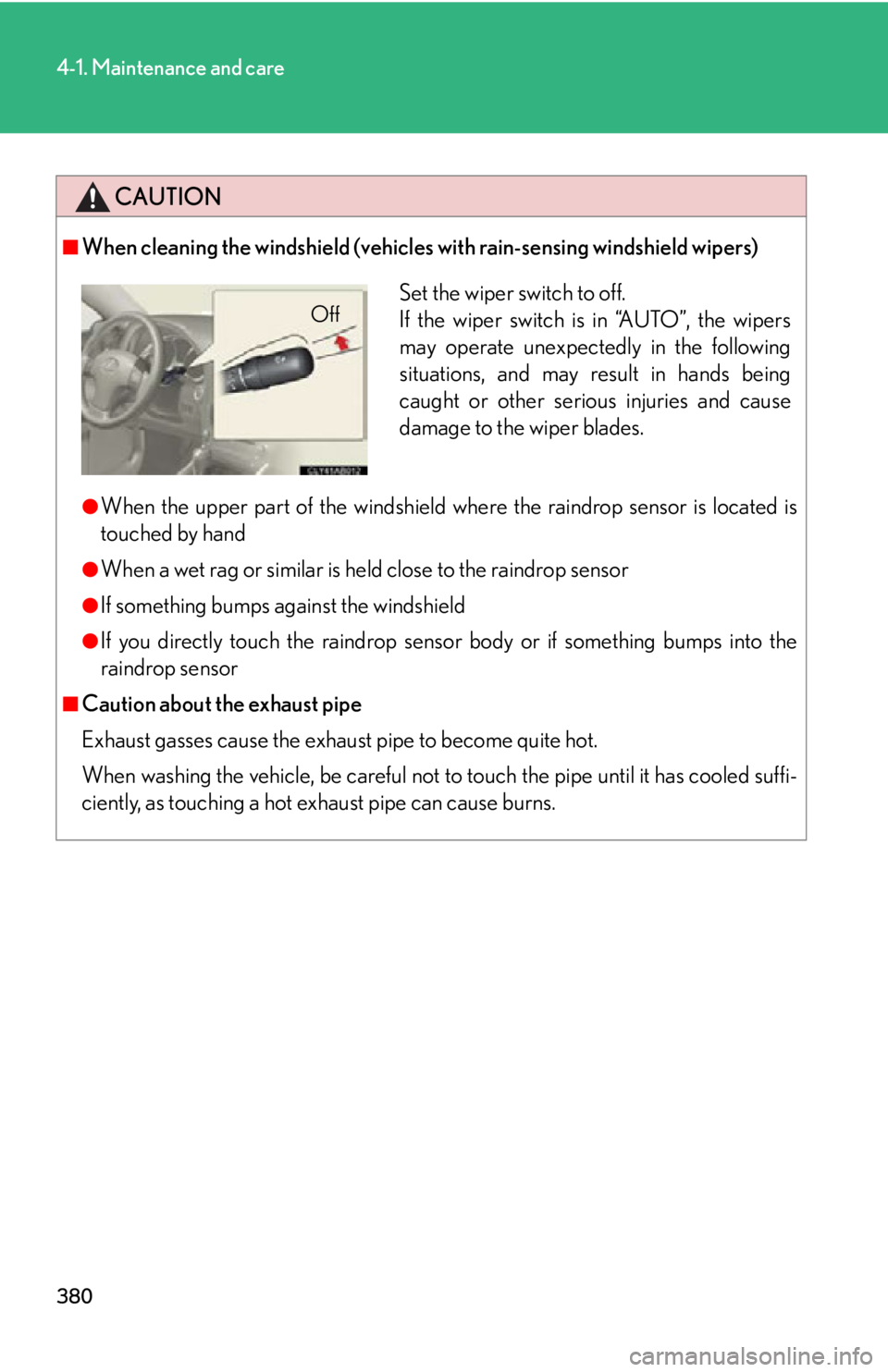maintenance Lexus IS250 2012 Using the air conditioning system and defogger / LEXUS 2012 IS250,IS350 OWNERS MANUAL (OM53A87U)
[x] Cancel search | Manufacturer: LEXUS, Model Year: 2012, Model line: IS250, Model: Lexus IS250 2012Pages: 592, PDF Size: 6.2 MB
Page 1 of 592

TABLE OF CONTENTS
1
1Before drivingAdjusting and operating features such as door locks, mir-
rors, and steering column.
2When drivingDriving, stopping and safe-driving information.
3Interior featuresAir conditioning and audio systems, as well as other interior
features for a comfortable driving experience.
4Maintenance
and careCleaning and protecting your vehicle, performing do-it-your-
self maintenance, and maintenance information.
5When trouble
arisesWhat to do if the vehicle needs to be towed, gets a flat tire,
or is involved in an accident.
6Vehicle
specificationsDetailed vehicle information.
7For ownersReporting safety defects for US owners, and seat belt and
SRS airbag instructions for Canadian owners.
IndexAlphabetical listing of informat ion contained in this manual.
Page 5 of 592

1
2
3
4
5
6
7
5
3-6. Using the storage featuresList of storage features............... 329
• Glove box ................................... 330
• Console boxes .......................... 330
• Overhead console ................... 332
• Cup holders................................. 332
• Bottle holders/door pockets ............................... 334
• Auxiliary box .............................. 335
3-7. Other interior features Sun visors......................................... 336
Vanity mirrors ................................ 337
Clock ................................................ 338
Satellite switch es .......................... 339
Ashtrays ........................................... 342
Cigarette lighter ........................... 343
Power outlet ................................... 344
Seat heaters.................................... 345
Seat heaters and ventilators .................................... 348
Armrest ............................................. 351
Rear sunshade ............................... 352
Trunk storage extension ........... 354
Coat hooks .................................... 355
Floor mat.......................................... 356
Trunk features................................ 357
Garage door opener................. 360
Compass.......................................... 366
Safety Connect ............................. 370 4-1. Maintenance and care
Cleaning and protecting the vehicle exterior................... 378
Cleaning and protecting the vehicle interior .................... 382
4-2. Maintenance Maintenance requirements.............................. 385
General maintenance ................ 387
Emission inspection and maintenance (I/M)
programs ..................................... 390
4-3. Do-it-yourself maintenance Do-it-yourself service precautions ................................... 391
Hood ................................................. 394
Positioning a floor jack............... 395
Engine compartment.................. 397
Tires .................................................... 412
Tire inflation pressure................. 424
Wheels ............................................. 428
Air conditioning filter................. 430
Electronic key battery ................ 433
Checking and replacing fuses ................................................ 435
Headlight aim ................................ 449
Light bulbs ........................................ 451
4Maintenance and care
Page 6 of 592

TABLE OF CONTENTSIndex
6
5-1. Essential informationEmergency flashe rs..................... 462
If your vehicle needs to be towed.............................................. 463
If you think something is wrong ............................................. 469
Fuel pump shut off system ........ 470
5-2. Steps to take in an emergency If a warning light turns on or a warning buzzer
sounds... ......................................... 471
If a warning message is displayed ........................................ 481
If you have a flat tire..................... 492
If the engine will not start ........... 501
If the shift lever cannot be shifted from P ............................. 503
If you lose your keys ................... 504
If the electronic key does not operate properly .............. 505
If the vehicle battery is discharged .................................... 510
If your vehicle overheats ............ 513
If the vehicle becomes stuck................................................. 516
If your vehicle has to be stopped in an emergency ....... 518 6-1. Specifications
Maintenance data (fuel, oil level, etc.).................... 520
Fuel information ............................ 537
Tire information.............................. 541
6-2. Customization Customizable features.............. 553
6-3. Initialization Items to initialize .......................... 559
Reporting safety defects for U.S. owners........................... 562
Seat belt instructions for Canadian owners
(in French) .................................... 563
SRS airbag instructions for Canadian owners
(in French) ................................... 565
5When trouble arises6Vehicle specifications
7For owners
Page 91 of 592

91
1-6. Theft deterrent system
1
Before driving
■System maintenance
The vehicle has a maintenance-free type engine immobilizer system.
■Conditions that may cause the system to malfunction
●If the grip portion of the key is in contact with a metallic object
●If the key is in close proximity to or touching a key to the security system (key
with a built-in transponder chip) of another vehicle
■Certifications for the engine immobilizer system For vehicles sold in the U.S.A.
FCC ID: NI4TMIMB-1
NOTE:
This device complies with part 15 of the FCC Rules. Operation is subject to the fol-
lowing two conditions: (1) This device may not cause harmful interference, and (2)
this device must accept any interference received, including interference that may
cause undesired operation.
FCC WARNING:
Changes or modifications not expressly approved by the party responsible for
compliance could void the user's authority to operate the equipment.
For vehicles sold in Canada
NOTE:
Operation is subject to the following two conditions: (1) this device may not cause
interference, and (2) this device must a ccept any interference, including interfer-
ence that may cause undesired operation of the device.
NOTE:
L’utilisation de ce dispositif est autori sée seulement aux deux conditions suivantes:
(1) il ne doit pas produire de brouillage, et (2) l’utilisateur du dispositif doit être prêt
à accepter tout brouillage radioélectrique reçu, même si ce brouillage est suscepti-
ble de compromettre le fonc tionnement du dispositif.
NOTICE
■To ensure the system operates correctly
Do not modify or remove the system. If mo dified or removed, the proper operation
of the system cannot be guaranteed.
Page 93 of 592

93
1-6. Theft deterrent system
1
Before driving
■System maintenance
The vehicle has a maintenance-free type alarm system.
■Points to remember before locking the doors
To prevent unexpected triggering of the alarm, make sure to check the following
before locking the doors:
●Nobody is in the vehicle.
●The windows and moon roof are closed before the alarm is set.
●The alarm system does not guarantee absolute security. To help prevent theft,
make sure to check that no valuables and so forth are left in the vehicle.
■Unexpected triggering of the alarm
In the following situations, perform an operation that will deactivate or stop the
alarm ( P. 9 2 )
■When the battery is disconnected
Be sure to deactivate the alarm system.
If the battery is disconnected before de activating the alarm system, the alarm may
be triggered when the battery is reconnected.
●When someone without a key is left in the
vehicle and the doors are locked.
When a door, the trunk or hood is opened
from inside the vehicle, the alarm may be
triggered.
●When the battery is recharged or
replaced, due to battery discharge and so
forth, after locking the doors.
The alarm may be activated when the hood
is opened and the ba ttery is reconnected
after the mechanical key has been used to
unlock the doors.
Page 377 of 592

Maintenance and care4
377
4-1. Maintenance and careCleaning and protecting the vehicle exterior............. 378
Cleaning and protecting the vehicle interior ............. 382
4-2. Maintenance Maintenance requirements ....................... 385
General maintenance .......... 387
Emission inspection and maintenance (I/M)
programs............................... 390 4-3. Do-it-yourself
maintenance
Do-it-yourself service precautions ............................ 391
Hood .......................................... 394
Positioning a floor jack ......... 395
Engine compartment ........... 397
Tires............................................. 412
Tire inflation pressure........... 424
Wheels ...................................... 428
Air conditioning filter ........... 430
Electronic key battery.......... 433
Checking and replacing fuses ........................................ 435
Headlight aim ......................... 449
Light bulbs ................................. 451
Page 378 of 592

378
4-1. Maintenance and care
Cleaning and protecting the vehicle exterior
■Automatic car washes
●Fold the mirrors back before washing the vehicle.
●Brushes used in automatic car washes may scratch the vehicle surface and
harm your vehicle’s paint.
■High pressure car washes
●Do not allow the nozzles of the car wash to come within close proximity of the
windows.
●Before car wash, check that the fuel filler door on your vehicle is closed prop-
erly.
Perform the following to protect the vehicle and maintain it in prime condi-
tion.
● Working from top to bottom, liber ally apply water to the vehicle
body, wheel wells and underside of the vehicle to remove any dirt
and dust.
● Wash the vehicle body using a sponge or soft cloth, such as a
chamois.
● For hard-to-remove marks, use car wash soap and rinse thor-
oughly with water.
● Wipe away any water.
● Wax the vehicle when the waterproof coating deteriorates.
If water does not bead on a clean surface, apply wax when the vehicle
body is cool.
Page 379 of 592

379
4-1. Maintenance and care
4
Maintenance and care
■Aluminum wheels
●Remove any dirt immediately by using a neutral detergent. Do not use hard
brushes or abrasive cleaners. Do not use strong or harsh chemical cleaners.
Use the same mild detergent and wax as used on the paint.
●Do not use detergent on the wheels when they are hot, for example after driving
for long distance in the hot weather.
●Wash detergent from the wheels immediately after use.
■Bumpers
Do not scrub with abrasive cleaners.
■Outside rear view mirror rain -clearing coating (if equipped)
Observe the following precautions in order to retain the rain-clearing properties of
the mirror.
●Clean the mirrors using car shampoo or glass cleaner that does not contain sili-
cone or an abrasive compound, and rinse thoroughly with water.
●Allow the mirrors to be exposed to direct sunlight for 1 to 2 days.
Page 380 of 592

380
4-1. Maintenance and care
CAUTION
■When cleaning the windshield (vehicles with rain-sensing windshield wipers)
●When the upper part of the windshield where the raindrop sensor is located is
touched by hand
●When a wet rag or similar is held close to the raindrop sensor
●If something bumps against the windshield
●If you directly touch the raindrop sensor body or if something bumps into the
raindrop sensor
■Caution about the exhaust pipe
Exhaust gasses cause the exhaus t pipe to become quite hot.
When washing the vehicle, be careful not to touch the pipe until it has cooled suffi-
ciently, as touching a hot exhaust pipe can cause burns.
Set the wiper switch to off.
If the wiper switch is in “AUTO”, the wipers
may operate unexpected ly in the following
situations, and may result in hands being
caught or other serious injuries and cause
damage to the wiper blades.Off
Page 381 of 592

381
4-1. Maintenance and care
4
Maintenance and care
NOTICE
■To prevent paint deterioration and corrosion on the body and components (alu-
minum wheels etc.)
●Wash the vehicle immediately in the following cases:
• After driving near the sea coast
• After driving on salted roads
• If you see coal tar or tree sap on the paint surface
• If you see dead insects, insect droppings or bird droppings on the paint
• After driving in an area contaminated with soot, oily smoke, mine dust, iron
powder or chemical substances
• If the vehicle becomes heavily soiled in dust or mud
• If liquids such as benzene and gasoline are spilled on the paint surface
●If the paint is chipped or scratched, have it repaired immediately.
●To prevent the wheels from corroding, remove any dirt and store in a place with
low humidity when storing the wheels.
■Cleaning the exterior lights
●Wash carefully. Do not use organic substances or scrub with a hard brush.
This may damage the surfaces of the lights.
●Do not apply wax on the surfaces of the lights.
Wax may cause damage to the lenses.
■To prevent damage to the windshield wiper arms
When lifting the wiper arms away from th e windshield, pull the driver side wiper
arm upward first, and repeat for the passenger side. When returning the wipers to
their original position, do so from the passenger side first.
■When using an automatic car wash (vehicles with rain-sensing windshield wipers
only)
Set the wiper switch to the off position.
If the wiper switch is in “AUTO”, the wipers may operate and the wiper blades may
be damaged.